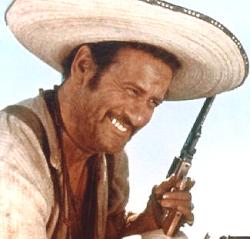
“When you’re gonna shoot…shoot. Don’t talk.” -Tuco
People either love Sergio Leone’s movies or they hate them. There is rarely a lukewarm response. His films are much more about what you see than what you hear. The dialogue is generally sparse, but the detail in the cinematography is immense. Notice how Leone shoots his actors. Rarely is there the standard waste-up shot, it is either full body in the distance or an extreme close-up on the face. It was said that Leone was fascinated with facial features, and only worked with actors who had “interesting faces”.
For those of you who don’t know much about Leone, he was the most famous director of the “spaghetti western”, so called because they were produced and directed by Italians (generally funded by German money and filmed in Spain). Like many Europeans of his generation, Leone was intrigued by all things American. And much like de Toqueville, it sometimes takes a foreigner’s eyes to really grasp the soul of America.

The Good (relatively speaking) - Clint Eastwood as Blondie
“The Good, The Bad & The Ugly” is the third film in a loose trilogy that brought both Leone and Clint Eastwood acclaim, but the films can be watched in any order, or even without seeing the others. The story is simple: three protagonists have a piece of information as to the whereabouts of some buried gold. None of them can find it alone, so they need each other only as long as it takes to find the resting place of the treasure. Alliances are formed and broken throughout. Doesn’t sound like much to fill 180 minutes, but the story is beside the point with Leone. Many fascinating side plots come and go: such as an unusually touching plot (for Leone) involving Tuco and his estranged brother, the very funny scam Tuco and Blondie have going together early in the film, and the great Civil War battle scene at the bridge. As this film was made in 1966-67, Leone was commenting as much on Vietnam as he was on the Civil War during these battle scenes. What was Eastwood really referring to when he said “never seen so many men wasted so badly” as he and Tuco watched the carnage? Could be talking about the Tet Offensive as much as Gettysburg.

The Ugly - Eli Wallach as Tuco
The dialogue is sparse at times but great throughout, the characters are unforgettable, the visuals will stay with you for a long time, and the actors are outstanding. Eastwood really became a star with this film, and it is easy to see why. Eli Wallach as Tuco is as lively and talkative a character as Leone ever allowed in his films. Tuco provides most of the humor and energy. Lee Van Cleef is perfect as the cold blooded Angel Eyes, rounding out the trio. Below is a great example of what I am talking about. Here Eastwood turns Wallach in for a reward. Tuco's diatribe has some great lines ("one bastard goes in, another comes out"; "Let me go and I will pardon you"). Notice how Eastwood doesn't say a single word the entire scene...
The final three-way duel in the cemetery is the stuff of film legend. Roger Ebert describes it best: “Examine the masterful scene in the cemetery. A fortune of gold is said to be buried in one of the graves, and the three men have assembled, all hoping to get it…Each man points a pistol at another. If one shoots, they all shoot, and all die. Unless two decide to shoot the third man before he can shoot either one of them. But which two, and which third? Leone draws this scene out beyond all reason, beginning in long shot and working in to close-ups of firearms, faces, eyes, lots of sweat and flies. He seems to be testing himself, to see how long he can maintain the suspense…If you savor the freedom with which Leone flirts with parody, you understand his method. This is not a story but a celebration of bold gestures." The build-up for that scene feels like it goes on for ten minutes. But the actual action? The guns are fired in about two seconds.
Another star of the film is composer Ennio Morricone. His distinctive music comprising of orchestra, twangy guitar and sound effects is as distinctive as Leone’s direction. Absolutely essential to the film.

The Bad - Lee van Cleef as Setenza, aka Angel Eyes
TGTBATU is a masterpiece. It is also Leone’s most accessible film, so I’d start there and then work back to the other two in the trilogy (A Fist Full of Dollars and For a Few Dollars More), and then check out Once Upon a Time in the West, which features another unforgettable trio of Charles Bronson, Jason Robards and the brilliant Henry Fonda, as well as the enchanting Claudia Cardinale.
A note on the recently restored version of TGTBATU. Most of the extra 20 minutes are entertaining but not essential, except for one scene that becomes one of the best scenes of the entire film. I am dumbfounded as to why it was cut from the original. It features a side trip taken by Angel Eyes to a Civil War hospital, where he is told there is a soldier who has some info on the possible whereabouts of the gold. It is a powerful scene, with a pan-shot that would make Martin Scorsese blush, and it adds some needed depth to the Angel Eyes character.

No comments:
Post a Comment